
Sydney Theatre Company (STC) is an Australian theatre company based in Sydney, New South Wales. The company performs in The Wharf Theatre at Dawes Point in The Rocks area of Sydney as well as the Roslyn Packer Theatre and the Sydney Opera House Drama Theatre.
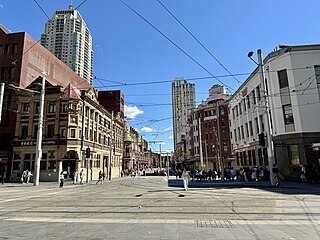
Haymarket is an inner city suburb of Sydney, New South Wales, Australia. It is located at the southern end of the Sydney central business district in the local government area of the City of Sydney. Haymarket includes much of Sydney's Chinatown, Thaitown and Railway Square localities. Haymarket is adjacent to Darling Harbour and is surrounded by the suburbs of Ultimo, Chippendale, Surry Hills and the Sydney CBD.

Chinatown is an urban enclave situated in the southern part of the Sydney central business district, in New South Wales, Australia. It comprises the majority of the Haymarket suburb, between Central station and Darling Harbour. It is part of the local government area of the City of Sydney, and is Australia's largest Chinatown.

The Birmingham Hippodrome is a theatre situated on Hurst Street in the Chinese Quarter of Birmingham, England.
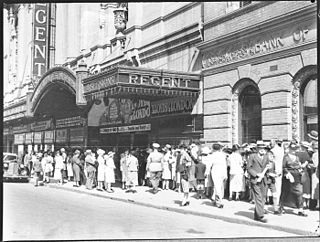
The Regent Theatre was a heritage-listed cinema and entertainment venue in George Street, Sydney, New South Wales, Australia, built in 1928 as a flagship for Hoyts, and was demolished in 1988 by property developer Leon Fink.

Theatre of Australia refers to the history of the live performing arts in Australia: performed, written or produced by Australians.

John Adolph Emil Eberson was an Austrian-American architect best known for the development and promotion of movie palace designs in the atmospheric theatre style. He designed over 500 theatres in his lifetime, earning the nickname "Opera House John". His most notable surviving theatres in the United States include the Tampa Theatre (1926), Palace Theatre Marion (1928), Palace Theatre Louisville (1928), Majestic Theatre (1929), Akron Civic Theatre (1929), the Paramount Theatre (1929), the State Theater 1927, and the Lewis J. Warner Memorial Theater (1932) at Worcester Academy in Worcester, Massachusetts. Remaining international examples in the atmospheric style include both the Capitol Theatre (1928) and State Theatre (1929) in Sydney, Australia, The Forum and Le Grand Rex.

The Newcastle Civic Theatre, also known as The Civic, is a heritage-listed building located on Hunter Street, Newcastle, Australia. Opened in 1929, the 1520-seat theatre is now the venue for a wide range of musicals, plays, concerts and dance events each year and is the city's oldest surviving theatre.

An atmospheric theatre is a type of movie palace design which was popular in the late 1920s. Atmospheric theatres were designed and decorated to evoke the feeling of a particular time and place for patrons, through the use of projectors, architectural elements and ornamentation that evoked a sense of being outdoors. This was intended to make the patron a more active participant in the setting.

The Sydney Markets are a group of wholesale and retail markets in Sydney, New South Wales, Australia. The Sydney Markets are located in the Inner West suburb of Flemington, New South Wales, 16 kilometres west of the Sydney central business district. Flemington is in the local government area of the Municipality of Strathfield. The market is the primary distribution hub of fresh produce, flowers and other food products for Sydney. The market has a wholesale sales section that caters to larger businesses and general sales to the public. The market is the central marketplace for Sydney's farmers to sell their products. It has a history dating back to 1788. The operator of the markets is Sydney Markets Limited, formerly the Sydney Markets Authority, but privatised in 1997. As well as the markets at Flemington, Sydney Markets Limited also operates the inner city Paddy's Market in Haymarket.

Her Majesty's Theatre, Sydney, Australia, refers to three theatres of the same name none of which remain standing. They were located in central Sydney on either Pitt Street or Quay Street.

The State Theatre is a 2034 seat heritage listed theatre located at 47–51 Market Street, in the Sydney central business district in the City of Sydney local government area of New South Wales, Australia. The theatre was designed by Henry Eli White with assistance from John Eberson and built between 1926 and 1929. It hosts film screenings, live theatre and musical performances, and since 1974 it has been the home of the annual Sydney Film Festival. It is also known as State Building and Wurlitzer Organ. The property is privately owned. It was added to the New South Wales State Heritage Register on 2 April 1999.

Sydney Lyric is a theatre in Sydney, New South Wales, Australia. It is part of The Star complex. The theatre is used for large scale musicals, theatre productions, concerts, opera and ballet. Formerly the Lyric Theatre, the venue changed to its current name in late 2011.
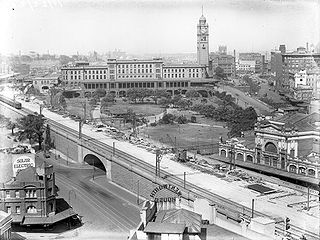
Belmore Park is a public park at the southern end of the Sydney central business district in the Australian state of New South Wales. Adjacent to the Central railway station, the park is bounded by Hay Street, Eddy Avenue, Elizabeth Street and Pitt Street. The area was previously known as Police Paddock and was part of a section of Crown land which included the Police Barracks, Devonshire Street Cemetery, Female Refuge of the Good Samaritan, Benevolent Asylum and a common.

Henry Eli White, also known as Harry White, was a New Zealand-born architect best known for the many theatres and cinemas he designed in New Zealand and Australia in the 1910s and 1920s. Many of the major surviving historic venues in the two countries are White designs, including the St. James Theatre, Wellington, St. James Theatre, Auckland, the Capitol Theatre and State Theatre in Sydney, and the Palais Theatre and the interiors of the Princess Theatre and Athenaeum Theatre in Melbourne. He also designed the City Hall and the attached Civic Theatre in Newcastle, New South Wales.

The following outline is provided as an overview of and topical guide to Sydney:
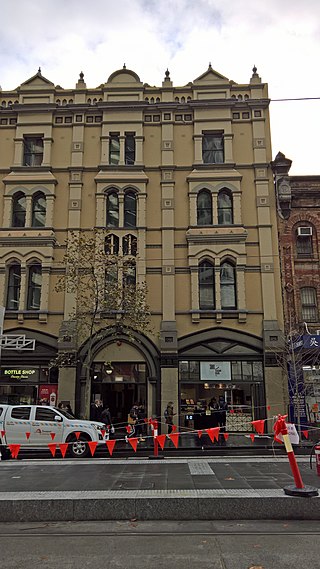
Haymarket Post Office is a heritage-listed former post office at 633–635 George Street, Sydney, City of Sydney, New South Wales, Australia. It was designed by E. Henderson and built from 1927 to 1928 by H. W. Thompson Ltd. It was added to the New South Wales State Heritage Register on 2 April 1999.

181–187 Hay Street, also known as the Corporation Building or Municipal Building, is a heritage-listed former council chambers located at 181–187 Hay Street, in the Haymarket district of Sydney, Australia. It was built from 1893. The property is owned by City of Sydney and was added to the New South Wales State Heritage Register on 2 April 1999.
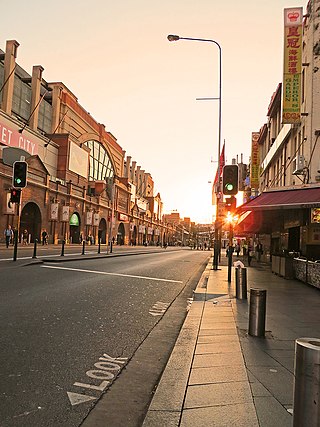
Hay Street is a 700 metre street in the Sydney central business district, New South Wales, Australia. It runs east to west from Elizabeth Street to Darling Drive. For much of its length it is traversed by the Inner West Light Rail line.

Wirth's Circus, also known as Wirth Brothers' Circus, was Australia's largest and most prestigious circus company for eight decades. Billed as Australia's own 'Greatest show on Earth', the travelling circus held an international reputation.























